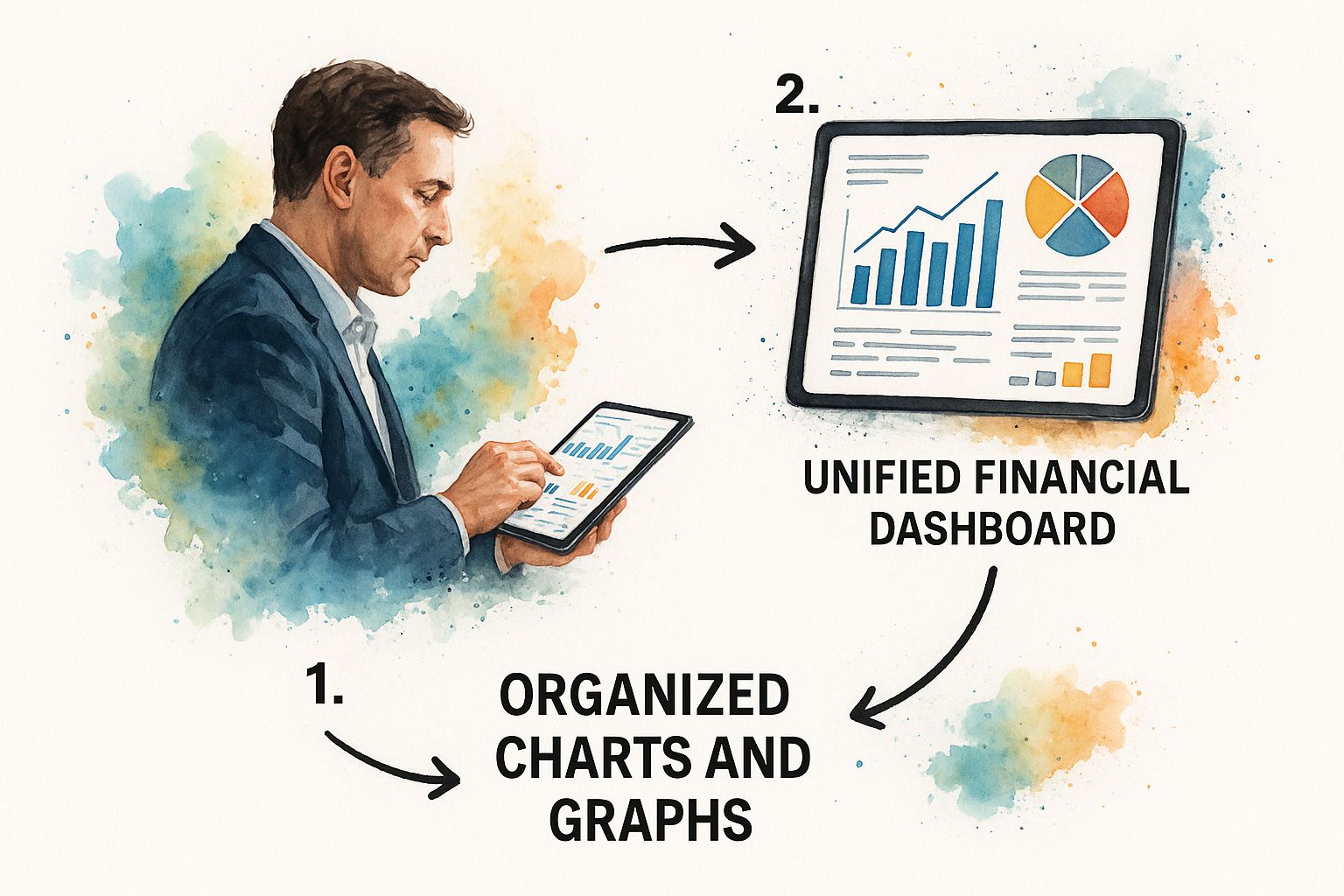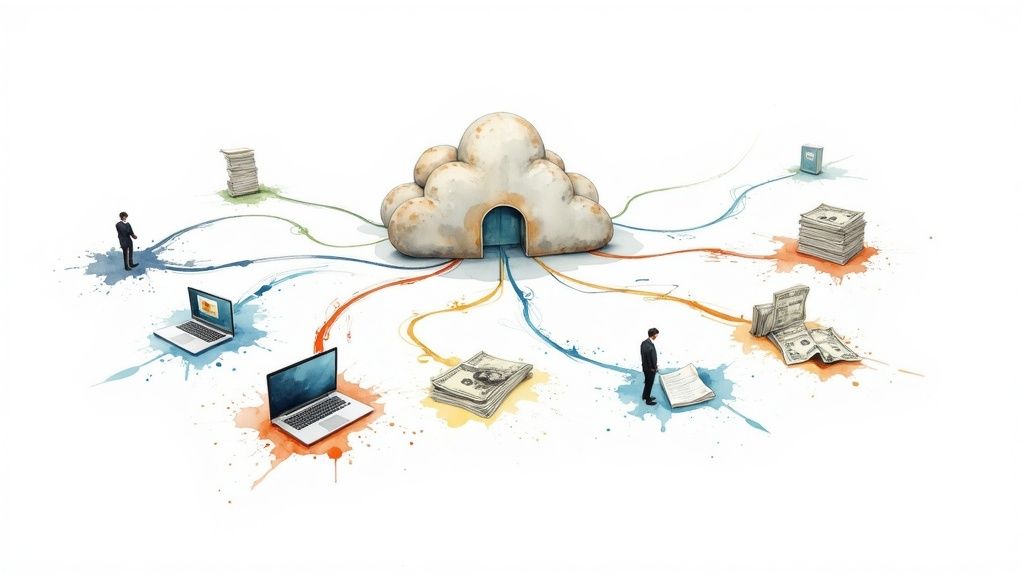Imagine trying to keep many balls in the air, each one representing a different bank account. Keeping track of checking, savings, investments, and credit cards can be stressful. This is where financial data aggregation helps. It’s like having a helper who manages all these accounts for you.
Instead of logging into many websites and sorting through statements, you can view all your financial info in one place. Think of it as your personal financial center. It gives you a clear view of your financial situation.
This single view is not just handy; it gives you power. You can quickly see trends, like how much you spend on eating out each month. It also helps you find areas to improve, such as paying off debt or changing your investment plan.
How Financial Data Aggregation Works
Financial data aggregation links to your different accounts—banks, investments, and credit cards—and brings the information together. It’s like having one key that opens all your financial data. This data is then shown in a simple format, making it easy to understand.
This picture from Wikipedia’s page on data aggregation shows how data from different places is combined into a summary. This is what happens with financial data aggregation. Scattered financial data becomes clear and useful.
Benefits for Businesses
Financial data aggregation is not just for people. Businesses, big and small, can get valuable insights. Think of a small business owner trying to track cash flow across different accounts. Aggregation can show patterns, helping them plan for slow times and manage spending better.
The Growth of Financial Data Services
The need for a single financial view is growing, shown by the rise in financial data services, including data aggregation. This market was worth USD 23.3 billion in 2023 and could reach USD 42.6 billion by 2031, with an 8.1% growth rate. You can learn more about financial data services growth here. This growth shows how important financial data aggregation is becoming.
Stock Decisions: Using Data for Better Investing
Platforms like Stock Decisions help investors by gathering financial data. They bring together information from many trusted sources. This turns complex market data into easy-to-understand insights. It’s like having a wise financial guide right at your side.
How Financial Data Gathering Works
Ever wonder how your finance app tracks all your spending, even from different accounts? It’s not magic. It’s financial data gathering. Think of it as a tool that lets different platforms talk and share information easily.

This infographic shows how you can see all your money information in one place. It makes it easy to understand and gives you better control over your finances. Picture having everything about your money in one simple spot—that’s what financial data aggregation does.
How It Works: APIs, Screen Scraping, and Open Banking
There are different ways to gather this data. An older way is called screen scraping. It’s like having a robot log into your accounts and copy the info. It works, but it’s not very safe.
A newer and safer way uses APIs (Application Programming Interfaces). APIs act like secure messengers. They let platforms talk to each other without needing your login details. Then, there is Open Banking. This is even newer and makes these connections more standard, clear, and secure. It’s like creating a common language for banks to talk safely.
Here is a look at how these methods compare:
Ways to Gather Financial Data
|
Method |
Security Level |
Reliability |
Speed |
Cost |
|---|---|---|---|---|
|
API Connections |
High |
High |
Fast |
Medium |
|
Screen Scraping |
Low |
Low |
Slow |
Low |
|
Open Banking |
High |
High |
Fast |
Medium |
As you can see, API connections and Open Banking offer significantly better security and reliability than screen scraping. While cost might be slightly higher, the trade-off for enhanced security and performance is generally worth it.
This screenshot from Plaid shows why safe and steady account links matter. An easy-to-use interface helps manage money, but strong security builds trust and peace of mind.
Security and Safety: Keeping Your Data Secure
Your financial data is sensitive, so safety is key. Good services use strong encryption to protect your data, both when it’s moving and when it’s stored. It’s like a digital safe for your information. They also stick to strict safety rules.
But, not all links are the same. Some, like those using screen scraping, can be weak. Imagine a website change breaking your link and stopping your data. Choosing a service with secure API links and Open Banking gives more stability. Stock Decisions knows this. That’s why we have strong safety steps and focus on steady data links.
Choosing the Right Service: A Key Decision
Picking the right service is a big decision. Think about safety, stable connections, and how many banks they support. A poor setup can cause errors, broken links, and frustration. Take your time to find a good service to make the most of your financial data. It’s like choosing a trusted money advisor – you want someone reliable and safe.
Real Benefits That Change How You Manage Money

Understanding Financial Data Aggregation
Financial data aggregation might sound technical, but think of it like a pair of glasses that lets you see your money clearly. Instead of looking at bits and pieces, you get a big picture. This helps you find insights you might miss otherwise. Let’s look at how this can help in real life.
Discovering Patterns and Saving Money
Imagine a small business owner who is always keeping track of expenses and income. They can’t figure out why their cash flow drops in some months. Financial data aggregation helps them spot a seasonal pattern in their sales. With this knowledge, they can plan better and avoid money problems.
Now, think of a couple who wants to manage their money better. By bringing their accounts together, they find $2,400 in fees they forgot about. This is money they can now use for their goals.
Finally, picture an investor who thinks their investments are well spread out. After checking all their accounts together, they see they have too much in one area. This puts them at risk. With this clear view, they can change their investments to be safer.
These are not just made-up stories. They show how financial data aggregation helps people take charge of their finances.
Smarter Budgeting, Investing, and Tax Preparation
Financial data collection acts like your own command center. It keeps all your data together, making budgeting simple and effective. You can track spending, set easy goals, and find ways to save money.
For investors, it offers a broad view of their holdings, showing hidden issues. They can adjust plans wisely with a full picture of their portfolio, removing guesswork and the need to log into several accounts.
During tax time, the advantages are clear. Picture having all income and expenses at your fingertips. No more rushing to find documents—just a smooth and easy process.
Extra Security and Wise Planning
Besides the obvious benefits, financial data gathering also brings unexpected perks. With all transactions in one place, automatic fraud detection becomes possible. The system can catch odd patterns across accounts and warn you of problems before they get worse.
Moreover, seeing your full financial picture helps you plan wisely. You can set big goals, keep track of progress, and make smart choices about your future. This complete view is key for success. The worldwide market for account aggregators shows this rising importance. In 2023, the market was worth USD 1.2 billion and might reach USD 4.8 billion by 2033, growing at a rate of 14.9%. Learn more about the financial data aggregation market here. These are just some ways financial data gathering can change how you handle your finances. By giving you knowledge and control, it helps you reach your goals.
Surprising Uses of Financial Data Aggregation
Financial data aggregation isn’t just for personal finance apps anymore. It now touches many areas you might not expect, affecting your finances in ways you might overlook. Imagine wealth managers using this to find hidden risks in portfolios for wealthy clients, or accountants making bookkeeping simpler for small businesses. These are just a few examples.
Boosting Wealth Management and Making Accounting Easier
In wealth management, advisors use financial data aggregation to see all their clients’ finances at once. This complete view helps them find risks and chances they might miss otherwise. For instance, they can quickly check a client’s assets across different accounts. This ensures the portfolio is varied and fits the client’s risk levels. This detailed look allows advisors to give better advice and strengthen client bonds.
Accounting firms also change how they do bookkeeping with financial data aggregation. Instead of gathering financial info by hand, they can automatically get data from various places. This saves time and effort, making things more efficient and letting accountants focus on giving strategic advice.
Improving Lending and Corporate Finance
Mortgage lenders use live cash flow data through financial data aggregation to speed up loan approvals. Instead of old financial reports, lenders get up-to-date data. This gives a clearer picture of a borrower’s finances, helping both lenders and borrowers.
In companies, CFOs use combined financial data for planning. With a clear view of all financial activities, CFOs make better choices about investments, resources, and growth. This data-driven method is key in today’s business world.
Driving Fintech Growth and Insurance Precision
Fintech startups are moving ahead, using financial data to create fresh services. Imagine getting investment advice based on how you spend or using tools that help you save money automatically. These are some ways fintech companies are helping people and changing the way financial services work.
The insurance industry is also changing due to financial data. Insurance companies now look at collected data to set more accurate premiums, matching them to real risks. This means fairer prices for customers. The market for financial analytics, which relies on this data, is growing fast. In 2024, it was worth USD 12.57 billion and it might reach USD 29.65 billion by 2033. It’s expected to grow at a rate of 8.96% from 2025 to 2033. This shows how important data insights are becoming in finance. You can learn more about this market in this research.
Below is a table showing how different industries use financial data:
Industry Applications of Financial Data
Overview of how various industries use financial data and their specific examples
|
Industry |
Primary Use Case |
Key Benefits |
Implementation Complexity |
|---|---|---|---|
|
Wealth Management |
Holistic client portfolio view & risk assessment |
Personalized advice, improved client relationships |
Medium |
|
Accounting |
Automated bookkeeping & reporting |
Increased efficiency, reduced manual effort |
Low |
|
Mortgage Lending |
Real-time cash flow analysis for loan approvals |
Faster processing, accurate risk assessment |
Medium |
|
Corporate Finance |
Strategic planning & resource allocation |
Data-driven decision-making, improved forecasting |
High |
|
Fintech |
Personalized financial services & automated tools |
Enhanced customer experience, innovative products |
Medium |
|
Insurance |
Risk profiling for accurate premium pricing |
Equitable pricing, improved risk management |
Medium |
This table shows the many ways people can use and benefit from services, like getting advice on money or speeding up loan steps. How hard it is to put these into place can change based on what you’re using them for and in which industry.
Stock Decisions: Helping Make Smart Investment Choices
Stock Decisions gathers financial data to give investors a clear view of market facts from different trusted sources. By putting this data in one place, we turn it into useful information. This helps users make smart investment choices. It lets investors see the whole picture before they decide, making things easier and leading to better results.
Navigating Common Challenges Without Losing Your Mind

Let’s be honest, gathering your financial info from different places can feel like chasing cats. One moment, everything is updated; the next, you’re looking at old data. This section talks about common problems and how to solve them.
The Puzzle of Broken Bank Links
Have you ever opened your budgeting app and noticed your accounts don’t show recent transactions? This is a sign of a broken bank link. These can break for many reasons, like website updates or security changes. Stock Decisions keeps these issues low by using strong API links with banks.
Think of it like this: instead of a shaky rope bridge (screen scraping), an API is like a strong steel bridge, giving a more steady and safe link.
When Banks Are Hard to Reach
Sometimes, getting your financial data is like pulling teeth. Some banks make it tougher than it should be, maybe due to security worries, lack of tech, or just not wanting to share data.
It’s like trying to borrow a book from a library that keeps it locked away. That’s why it’s key to pick a service that works with banks, ensuring smooth and steady information flow.
Understanding Confusing Transaction Data
Have you ever looked at a transaction in your budgeting app and thought, “What is this?” Sometimes, the data can be a mess. Transactions might be in the wrong category, descriptions could be missing, or the amounts might be wrong.
It’s like trying to finish a puzzle with missing or mixed-up pieces. The fix? Find services that clean and sort data well. These should let you fix mistakes by hand and teach the system about your spending habits.
Balancing Privacy Concerns and Benefits
You might worry about sharing your financial data. It’s like giving someone the keys to your home. You want to make sure it’s safe. Good services use strong encryption and secure methods to protect your data.
They are like trusted friends who keep your house safe while you’re away.
Understanding Technical Limits
No system is perfect, and financial data tools are no exception. Some banks don’t allow direct access, so less secure methods might be needed. Differences in how banks format data can make things hard.
It’s like trying to mix ingredients from different recipes. Sometimes, the instructions don’t fit. Knowing these limits helps you have realistic expectations.
Navigating Rules and Picking the Right Solution
Rules about financial data vary around the world, making things complex. Some places use open banking, which allows safe data sharing. Others don’t, leading to a mixed situation. This shows why it’s important to pick solutions that follow all rules and keep your privacy safe. Platforms like Stock Decisions manage these challenges, giving you a smooth and secure experience.
Getting Financial Data Aggregation Right From The Start
Success with combining financial data isn’t just about picking the best software. It’s about careful setup and regular upkeep. Think of it like building a house. Choosing the right materials matters, but the building process and regular maintenance are what keep it strong over time. This section gives simple advice from both successful and not-so-great experiences.
Choosing the Right Platform: Asking the Key Questions
Picking a platform is like choosing a financial advisor. You wouldn’t trust anyone with your money, right? Here are some important questions to think about:
Security: How does the platform protect your data? Look for strong encryption, two-factor security, and good industry practices.
Reliability: How often do things go wrong? Pick platforms that use stable API connections and avoid methods that cause interruptions.
Compatibility: Does it link to all your financial institutions? Make sure it supports banks, investment sites, and credit cards.
User-Friendliness: Is it easy to use? A messy dashboard can make things harder.
Customer Support: Is help available when you need it? Good and quick support can be very helpful.
Smooth Integration: Preparing Your Accounts
Before connecting your accounts, a little prep work helps a lot:
Gather Account Information: Have your account numbers, usernames, and passwords ready.
Review Security Settings: Make sure each account has a strong, unique password and use two-factor security when you can.
Check for Compatibility: Make sure your platform works with all your institutions before you start.
Security First: Protecting Your Data Without the Hassle
Security should be a top priority, but it shouldn’t be a headache. Follow these practices:
Strong Passwords: Use unique and complex passwords for every financial account and your aggregation platform.
Two-Factor Authentication: This extra layer of security is a must-have whenever available.
Regularly Review Connected Accounts: Periodically check that only necessary accounts are connected and disconnect any you no longer use.
Quality Control: Keeping Your Data Accurate
Imagine a map with incorrect information – it won’t get you where you need to go! Inaccurate financial data is just as detrimental. Here’s how to maintain data quality:
Regular Reconciliation: Compare your aggregated data against your individual statements to identify any discrepancies.
Categorization Review: Make sure transactions are properly categorized for an accurate view of your spending.
Address Errors Promptly: Contact your platform’s support team if you spot incorrect or missing data.
Maintenance Routines: Preventing Small Issues From Becoming Big Headaches
Like a car, your financial data aggregation setup needs regular maintenance. These practices prevent small issues from becoming major problems:
Regularly Update Connections: Keep the data flowing smoothly and minimize broken connections.
Monitor for Notifications: Pay attention to alerts from your platform regarding connection issues or data discrepancies.
Stay Informed: Stay abreast of changes in security protocols and best practices.
Advanced Techniques: Taking Your Aggregation to the Next Level
Once you’re comfortable with the basics, explore these more advanced features:
Custom Categorization: Tailor categories to track spending according to your specific financial goals.
Automated Reconciliation: Automate transaction reconciliation and save yourself time and effort.
Build Expertise: Deepen your understanding of your chosen platform to fully utilize its potential and minimize reliance on customer support.
By using these strategies, you can fully use financial data and take charge of your money. Platforms like Stock Decisions show these practices by focusing on safety and reliability, giving investors a smooth and empowering experience. These insights help you avoid mistakes and achieve long-term success with financial data.
What’s Next for Financial Data
Financial data is always changing. New technology and user needs keep it moving. Let’s look at exciting trends that will change how we handle our money.
AI for Smart Spending
Imagine your money app not only showing past expenses but explaining why you spent and predicting future costs. AI helps with more than just reports. It finds spending habits, warns about overspending, and offers ways to save. This shift helps you manage money better and avoid problems before they start.
Blockchain for Safe Sharing
Blockchain offers strong security for sharing data. Think of it as a digital list that can’t be changed. It logs every transaction, cuts fraud risk, and builds trust with banks. This also makes it easier to follow rules and check records.
Open Banking and Fast Updates
Open banking helps banks talk the same way, making data sharing easier. It helps services connect and get data smoothly. Real-time processing stops annoying delays. Instead of waiting days, you’ll see updates fast, giving you a current view of your money.
Mobile-First Approach for On-the-Go Insights
With more people using mobile banking, it’s crucial to access your financial information anytime, anywhere. A mobile-first approach focuses on making this easy on your smartphone or tablet. You can check your investments during your commute or adjust your budget while shopping, giving you full control.
Emerging Technologies: Quantum Computing, IoT, and AR
In the future, technology like quantum computing could speed up how we process financial data, helping us do things we can’t do now. The Internet of Things (IoT) could add new data sources, like smart appliances, providing a complete financial picture. Augmented reality (AR) might let us see our finances in new ways, like showing charts right in front of us.
Evolving Regulatory Landscape and Privacy Protection
As financial data tools get stronger, rules need to catch up. Governments are working to find a balance between sharing data and keeping it private. Better encryption and ways to hide data identity offer good solutions.
Integration with Emerging Financial Services
Financial data tools are ready to work with new services like digital money and decentralized finance (DeFi) platforms. This could create a system where managing both regular and digital money is easy.
By learning about these trends, you can prepare for the future of financial data. This helps you make smart choices about your technology plans. Stock Decisions is at the front of these changes, always finding new ways to give investors top tools and insights. Start making better financial decisions today and discover Stock Decisions at https://yourwealthsignal.com.
